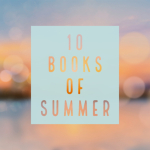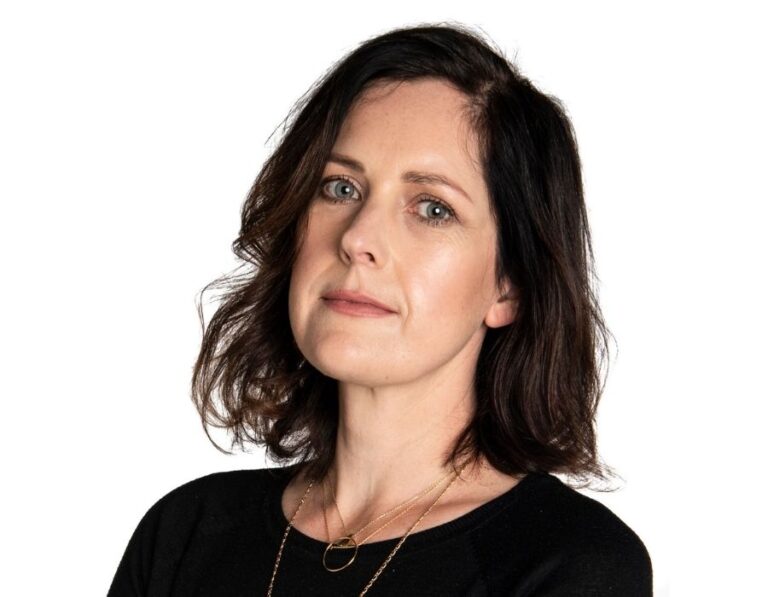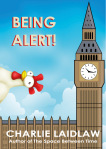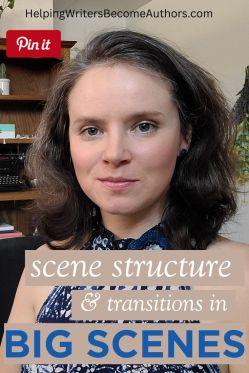
Hello and welcome! Today’s question is from Grace Clay who asks:
I would like more advice about transitions, please. In particular, transitioning out of big set pieces. The best books—well, my favorite books—tend to follow up their massive orchestral scenes with something a little more contemplative to let the audience catch their breaths, but how you make that transition is still beyond me.
As I was thinking about what to call this video (watch here if you prefer), one of my working title ideas was “Something Big Just Happened in My Story—Now What?” :p
This is a really good question. We all come up with big scene ideas. They’re very often the ones that inspire the story. They’re the ones we are looking forward to writing, and therefore we build our stories around them. Yet it can be tricky to get into them and get out of them.

How to Use Story and Particularly Scene Structure to Create Transitions
One of the main things to think about in creating transitions for big scenes is story structure. Are these scenes properly being built into and properly being built out of within the entire structure? You don’t want them to feel like they’re stuck in there just because the author really, really liked the idea. I’ve written a couple scenes like this myself, so if you’re doing this, I can totally commiserate!
More to the point of the actual transition, the thing to think about here is scene structure. Scene structure is literally about this ebb and this flow between the bigger, more dramatic moments and the softer, more contemplative ones that follow. This mirrors what happens in life when something big happens and then we have to rest and integrate and think about what’s happened before we can move on to the next thing. That is what scene structure allows us to recreate in our stories.
Classically, scene structure is broken down into two halves which are called scene and sequel. Really, these are just about action and reaction. The scene half aligns with action and the sequel half with reaction. We can also think of these as cause and consequence. First, we have the scene in which something happens, then we have the scene in which the fallout happens and there has to be readjustment. People have to think about what went wrong and what went right? They have to think about what they’re going to do next as they continue to pursue their plot goals.
The beauty of this is that when you set these up properly, each one naturally leads into the next. You end up with this beautiful line of dominoes. I often talk about how you want each scene to be a domino in a row of dominoes. When you hit that first domino, the whole thing just runs smoothly and the transitions almost happen of their own accord.
Structuring Your Story’s Scenes: Action
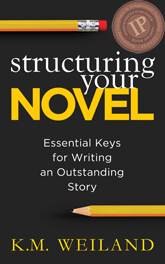
Structuring Your Novel (Amazon affiliate link)
I’ve talked in depth about scene structure often on my website and also in my book Structuring Your Novel. You can look there for more information on this, but just briefly so you understand what I’m talking about: When I talk about scene structure, you can break scene down into two halves, scene and sequel.
The scene half, which is focused on action, is then further broken down into a focus on the character’s goal.
Conflict or opposition then arises to that goal.
And then the outcome of whatever happens when that goal meets that opposition.
Usually, throughout most of the story until you get to the end, scene outcomes will have some sort of a disastrous flavor, in the sense that either the character doesn’t get what they wanted in that scene or they get what they wanted but there are unforeseen complications or consequences. If there aren’t consequences—if they just can immediately get everything they want—then they get to the plot goal very quickly and the story is over. Conflict and its complications create the plot and allow us to extend the character’s problem over the course of an entire story.
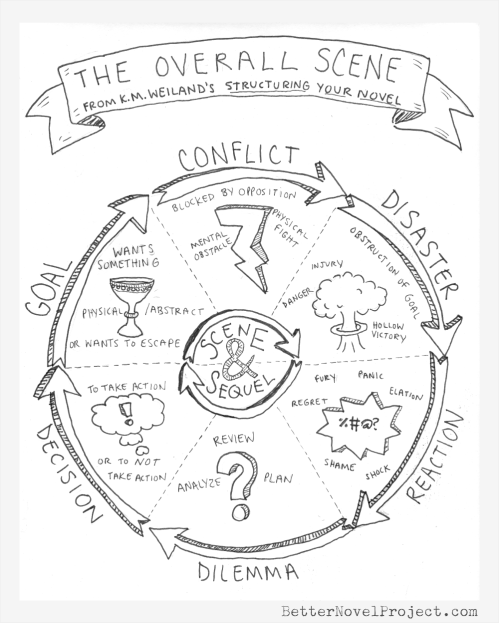
Structuring Your Story’s Sequels: Reaction
After your characters reach the outcome–or disaster—of a scene, they move into the reaction half, which is called sequel.
This is where the characters react to whatever just happened, whether it was big or small.
They face the dilemma that has emerged because they didn’t completely get what they wanted. Or even if they did now, they have to think about what they’re going to do with it and what comes next. A
Out of that dilemma will arise a decision about what they’re going to do, which lead directly into the next scene’s goal.
You can see how it’s a cycle where each piece beautifully bumps into the next. You don’t have to fully express or dramatize every single part of the scene’s structure. It will depend on how much emphasis you want to put on each part.
If you’re focusing more on fast pacing, drama, and conflict, you’re going to put more emphasis and more time into the action half of the scene. Whereas if you’re wanting to slow it down and make it more character-driven, more introspective and about the inner conflict and the inner consequences of what’s happened previously, then you’re going to want to extend that sequel half and focus more on the character’s reactions. It depends on the pacing.
Planning Your Big Scene Transitions
You can think in terms of trying to balance these things. So when it comes to the big set-piece scenes like Grace, these scenes are necessarily designed to create consequences. They’re designed not just to create little scene-level consequences of, Oh I didn’t quite get what I wanted. Rather, these scenes feature big, story-level consequences of, Whoa this completely changed my life! or This just completely changed my perspective of the nature of the conflict or my relationship to the plot goal! That creates massive consequences and requires a lot of integration and some introspection from characters.
The action in your story could be literal action as we think of in action movies with car chases and shootouts. But “action” is whatever is the primary drama within your story. So it could be relational. In certain types of story, it could be your character talking to the moon or something like that.
Identify the primary action within your story. Where is the plot is moving? Where the character is making progress toward the plot goal? Then balance that with reaction to the consequences that have been created in their relationship to how they’re moving forward in the world. Now, they have to think about and integrate what’s happened and how it’s going to change them and their perspectives.
Think About Where You Will Develop Character Relationships
The sequel section, after a big scene, is often a time where there is a lot of development within relationships between characters as they integrate together. Maybe there’s apologizing, maybe there’s recalibrating, maybe there’s explaining about motivations and things—converstations there weren’t necessarily time for in previous scenes.
These quieter and more contemplative scenes are so important for maintaining the realism within a story. They prove how your characters have changed and why they’ve changed. They create realism for how this change evolves and plays out within a story, so that it mirrors what we experience in real life.
Pay Attention to Pacing in Big Scene Transitions
The balance of scene and sequel is important in affecting pacing. Without the contemplative sequel parts of the scene, you end up with a madcap story that never quits. Some stories are designed to emphasize the action part of the scene. They don’t slow up too much. But they still require some ebb and flow. Very few stories can survive and be successful without some balance of action and reaction, cause and consequence.
Truly, the most interesting thing about what happens in a story is the consequences. It’s less about the action and what the character does and more about the outcome that results from their actions. Characters have to grapple with the complexity that often comes from those consequences.
Sequel scenes are almost always my favorite to read or watch or write. That’s not to say I don’t love the action scenes, because I do. But there’s just something really juicy about a good reaction scene, a good sequel scene.
You definitely want to figure out how to execute these reaction moments within your story. The single best way to do that is to pay attention to that ebb and flow, that balance in scene structure of action and reaction. It literally allows the transitions to build themselves. You’re just following the characters as they move through the story. They move through the action part where they have a goal, where there’s consequences. From there, they immediately move into addressing those consequences and dealing with them. The consequences then roll over into the next part of the action where the characters try to do something again.
From there, the cycle repeats itself but in an upward spiral, in which the characters are perpetually learning how to be more effective in their actions and how to refine their perspectives in the character arc. That’s what allows the story to evolve and repeat this pattern without feeling repetitive. It feels like it’s evolving and deepening the story.
Use Scene Breaks to Hook Readers
You want to end your scenes on some kind of a hook, something that makes readers curious about what’s going to happen. This doesn’t have to be a big deal. It doesn’t have to be a jump scare or something where readers are like, “Oh my gosh, I didn’t see that coming!” You don’t need a plot twist every single scene break. But try to make readers curious how the characters are going to respond. When something big has happened, that’s a good place to end because there’s about to be reactions and consequences for the characters to sort through. Readers forward to find out how characters will react.
The best way to think of a hook, in my opinion, is just as a question. It doesn’t have to be an explicit, literal question, but just something that gets readers wondering. It’s a loose end. It’s makes readers think, “We don’t know what’s going to happen here. We don’t know how the character is going to react.” That is often enough to pull readers into the next chapter or scene. It promises a really good scene and readers can imagine, “Oh, this, this confrontation is going to be juicy!” That, too, can be enough to pull them into the next scene.
Use a Bridging Technique for Your Scene Breaks
On a more technical level, one way to create an elegant transition is a bridging technique. This is kind of where choose something at the end of the previous scene break that can be mirrored in the beginning of the next. In film, we often see this in scene transitions where the camera focuses on something that’s a circle in one scene, then the scene fades out and back in to show a circle in the next scene. It’s a visual cue that helps viewers switch over to the new scene.
Obviously, you can’t do that in written fiction, but you can focus on imagery and symbolism, on things that are similar from one scene to the next. You don’t want to be too on the nose about this or draw too much attention to it. When it’s done right, it can allow you to ease readers through that transition.
Something kind of fun I did with in my last work in progress was to challenge myself when I wrote the beginning of a new scene to incorporate a word in the first line of that scene that was also in the last line of the previous scene. For instance, maybe “cathedral” was a word in the last sentence of the previous scene. I would then try to find a way to pull that, or any other word in the sentence, forward into the next scene.
The idea was that it wouldn’t necessarily be something readers would be conscious of, but that it would segue between scenes. Mostly, it was just for fun, but that gives you an idea about bridging and how you can try to create resonance between the closing of one scene and the beginning of the next, just with your language and with your words.
Never Lie to Readers in Your Scene Transitions
The most important thing to keep in mind when it comes to scene breaks and chapter breaks is you don’t want to lie to readers. You want to pique their curiosity and pull them into the next scene or chapter, but you want to do so honestly. For example, you might create a situation in which it seems like something terrible or something really intriguing or exciting has happened. It pulls readers on and they think, “Oh, that’s interesting!” But when they move on to the next scene, they find out it was all a joke. For instance, they think the bad guys are attacking the base, but it turns out it was just a practical joke from the hero’s buddy. Generally speaking, that’s not effective. Not only is it annoying to readers, but it literally doesn’t advance the plot. If it does advance the plot, that’s different. But don’t construct this fake drama and tension to pull readers in, only to tell them, “Oops, just kidding! It really wasn’t like that!”
***
There’s a lot to transitions in general, which I didn’t talk about today because I wanted to focus specifically on how to work with the big scenes in comparison to the small scenes. I have linked to resources throughout the post, if you want more information.
Happy writing!
Wordplayers, tell me your opinions! How did you handle the scene structure and transitions in the last big scene you wrote? Tell me in the comments!
Click the “Play” button to Listen to Audio Version (or subscribe to the Helping Writers Become Authors podcast in Apple Podcast, Amazon Music, or Spotify).
___
Love Helping Writers Become Authors? You can now become a patron. (Huge thanks to those of you who are already part of my Patreon family!)


